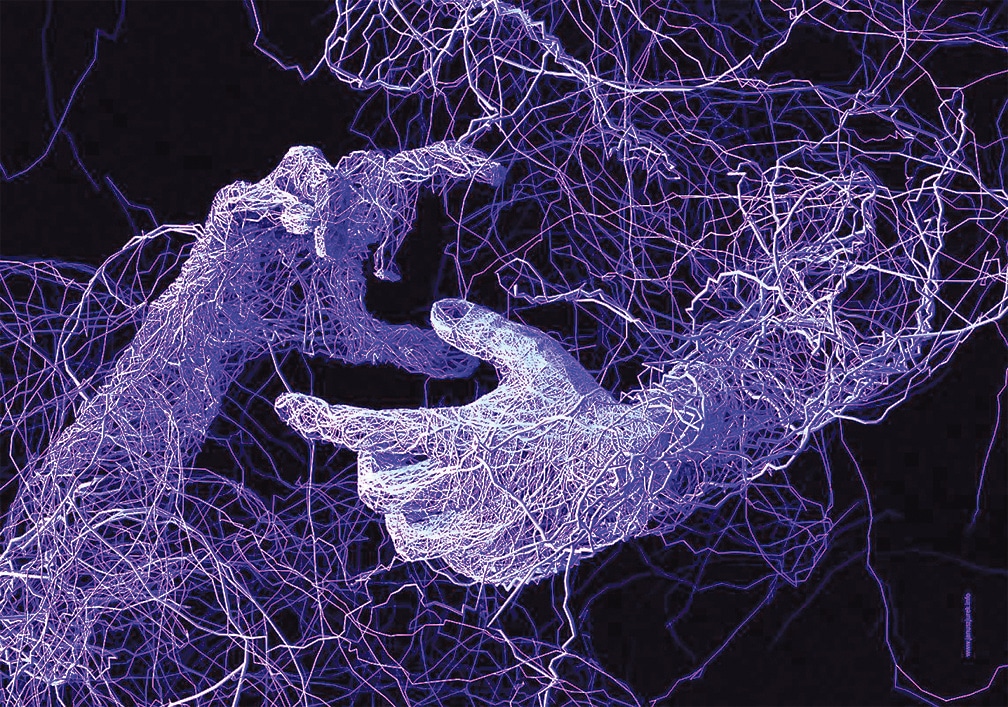
In recent articles I have been examining how diet and lifestyle impact our bodies in relation to inflammation and chronic pain. Today I want to examine the importance of our fascial network for our overall well-being, both mentally and physically and suggest some ways we can support this incredible system.
Fascia is a thin casing of connective tissue which is both strong and flexible, a ‘natural bandage’ that holds muscles and organs in place. For years it was cut away by anatomists researching the body because it got in the way of the more interesting organs, muscles and bones. It is viewed very differently today.
It is a fluid cobweb-like net that penetrates, surrounds and connects our bones, muscles and organs. In fact it connects our whole body. It works in parallel with the nervous system and the bloodstream. It also transmits the force of the muscles acting on our bones, which enables movement. It functions as a sort of ‘super-suit’, holding us together. If we experience a strong impact from an external force like a fall or an injury, the fascia will contract strongly and hold together in order to protect the body.
Our body patterns and habits also affect our fascial network. How we wear our suit has an impact, so for instance if we consistently cross one leg over the other or use our right hand for all actions, we ingrain a repetitive pattern into our fascia. This pulls and twists the fascia into a particular shape, one that is particularly individual. Our physical bodies are actually shaped through our individual and unique human experiences; our ways of doing and being in this world. Fascia twists and pulls, gathers up in clumps in some parts and stretches thin and becomes fragile in others. It is the landscape of our individual movement. Not only does it shape us physically, the latest findings have discovered that it may shape how we experience our sense of self, some even positing the case that it is the source of our consciousness. In 2022 not only did scientists discover that the fascial network was rich with nerve endings, they also estimated that there were approximately 250 million of them located there, making the fascial network our richest and largest sensory network, richer even than our organ of touch (skin) and our organ of sight, which was always believed to have the richest number of nerve endings.
The fascia is constantly transmitting signals to our brain from our body. It is a superhighway of felt sensation and information. Our self perception comes from the fascia, even in something as simple as standing upright.
The sense we have of our own body in relation to its surroundings, our spatial awareness, comes directly from the fascial network. But also and perhaps more fascinatingly, our inner awareness comes from this network and here we have the awareness of our sense of self, that felt quality of the body, before we put emotions or thoughts to it.
This sense of ‘self’, encompasses our ‘gut feeling’ or our instincts. It is our sense of being an individual. And interestingly we have far more receptors given over to experiencing our inner sense of self than to our sense of ourselves in the external environment. Signals from these interoceptors which perceive the inner state of our body, travel through the spinal cord to the brain where they enter the insula, a region of the brain in the cerebral cortex, which according to neurologists is responsible for our sense of self and our emotional state.
It can be argued that our consciousness is based on our brain’s processing of these transmitted signals from our cells. The ways in which we view the world, our outlook, how young or old, inspired or alive or tranquil or tired we feel…our inner state may come down to what is being transmitted by our fascial network. It has even been hypothesised that it’s the fascia which holds our memories, stored in its tissues. So much remains undiscovered in this mysterious matrix of fascia.
Everything we have experienced throughout our lives, the pain of our traumas, our joys and our sorrows, all our physical, emotional and spiritual experiences have left their mark on this exquisitely sensitive network, which it would seem, makes us who we are.
So what are the requirements to ensure a healthy fascial network?Fascia is negatively impacted by poor sleep, dehydration, stress, poor diet and lack of movement. When fascia becomes unhealthy through poor lifestyle choices or through injury, it gets sticky and dense and can adhere to bone, muscle and organs with enormous force. It loses its flow and spaciousness and becomes an inefficient network that can no longer clear toxins and allow flow in the body. Without flow, there is stagnation, which leads to a frozen or stuck sense of our body and mind.
Fascia is the network that facilitates the mind-body connection we speak of in Pilates, yoga and Feldenkrais. So how do we clear the blockages and create flow? Making healthy lifestyle choices goes a long way but there are two particularly crucial ways in which we can support our fascia.
Conscious Breathing
Because we are so often stressed and busy, we are breathing inefficiently. Sitting for long periods causes us to slump and our diaphragm to ‘collapse’, which means we are not filling our lungs fully. We breathe instead into the top of our lungs or shallow breathe into our upper chest. This deprives our cells of oxygen, which also contributes to toxicity and inflammation, which is why conscious breathing is one of the best things you will ever do for your health.
Diaphragmatic breath can be practiced sitting, standing or lying down as follows:
Draw the breath deep down into your lower abdomen, feeling your diaphragm rise and the ribs expand and fill your lungs. Sense your in-breath as an inner stretch for your abdomen and torso. Relax into the out-breath making sure it is longer than the inhale, so you can bring your nervous system into relaxation. Know that the breath is actually nourishment for the fascial network and for your overall health. Three minutes is sufficient to start with and it can be done at any time and several times daily. The overall aim is to become conscious of our breathing throughout our day, noticing when we are shallow breathing, slumping or holding our breath. As you enrich your cells with oxygen you will be rewarded by a clear, calm mind and renewed energy.
Movement
Free flowing movement is really important for the fascial network. Gentle bouncing and swinging and stretching movements are best. Think of how children jiggle and move and hop about. Bring an element of play to your movements; this is nourishing because it allows for spontaneity and creativity, essential antidotes to the seriousness of the adult repertoire of movement, which is either work-oriented or exercise-oriented. Spontaneity is perhaps the key word in movement for your fascia.
I am a great advocate of an all-over-body shake. It really helps when we are feeling stuck or are dealing with an overwhelming emotion, as it releases the charge in the body. Remember, what we hold onto, holds onto us and this repression of our expression can lead to tension and pain, as our fascia holds on. A gentle shake-out in the privacy of your own home, done with awareness, can really help in these matters. So, reclaim your inner child. Be creative and breathe and you will bring life to your tissues.



